Child Health and Wellbeing: CHCECE005 Assignment Solution Details
VerifiedAdded on 2022/11/29
|8
|2111
|225
Homework Assignment
AI Summary
This document provides a detailed solution for the CHCECE005 assignment, focusing on supporting child health and wellbeing. It begins by defining key terms such as 'baby' and 'toddler' and explores effective communication methods between adults and infants. The assignment addresses various aspects of childcare, including settling babies into a caring environment, licensing regulations, and the importance of supervision. It also covers potential risks in a care setting, bedtime routines, hygiene practices, and nutritional issues. The document outlines procedures for preventing the spread of infection and handling suspected cases of child abuse. Furthermore, it presents scenarios focusing on emotional security, nappy changing, toy safety, feeding procedures, and handling difficult situations, providing practical solutions and advice. Finally, the assignment includes a list of references to support the information provided.
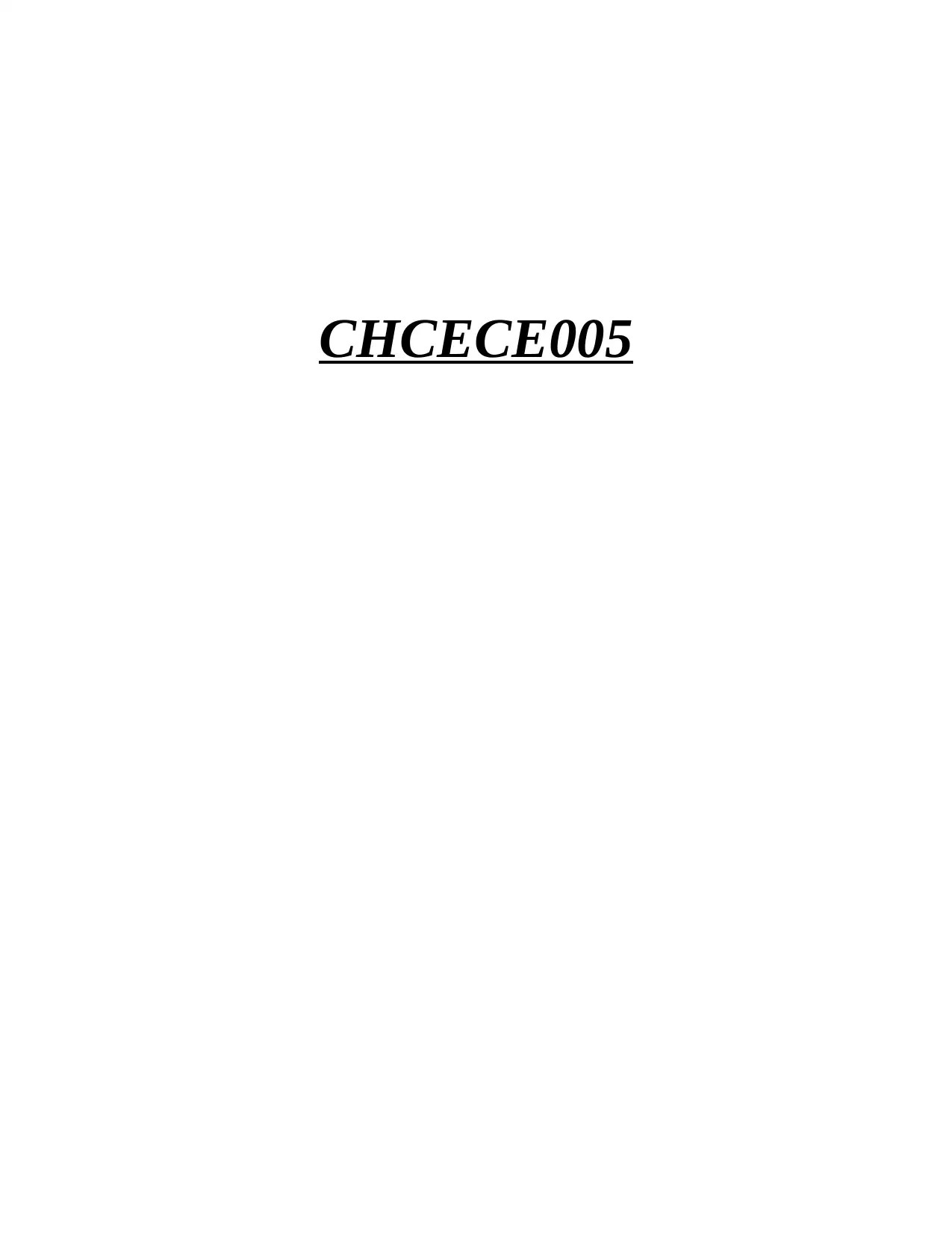
CHCECE005
Paraphrase This Document
Need a fresh take? Get an instant paraphrase of this document with our AI Paraphraser
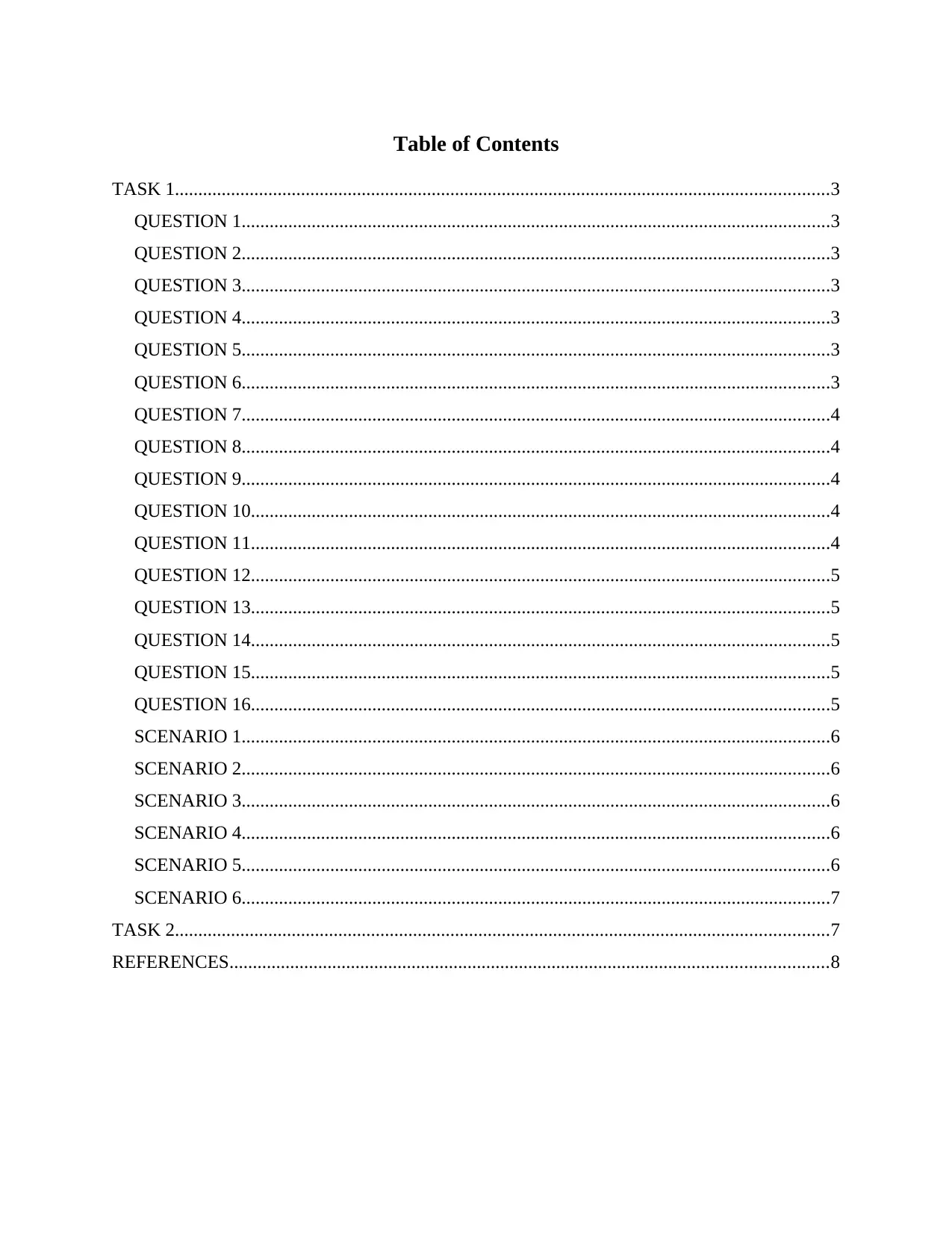
Table of Contents
TASK 1............................................................................................................................................3
QUESTION 1..............................................................................................................................3
QUESTION 2..............................................................................................................................3
QUESTION 3..............................................................................................................................3
QUESTION 4..............................................................................................................................3
QUESTION 5..............................................................................................................................3
QUESTION 6..............................................................................................................................3
QUESTION 7..............................................................................................................................4
QUESTION 8..............................................................................................................................4
QUESTION 9..............................................................................................................................4
QUESTION 10............................................................................................................................4
QUESTION 11............................................................................................................................4
QUESTION 12............................................................................................................................5
QUESTION 13............................................................................................................................5
QUESTION 14............................................................................................................................5
QUESTION 15............................................................................................................................5
QUESTION 16............................................................................................................................5
SCENARIO 1..............................................................................................................................6
SCENARIO 2..............................................................................................................................6
SCENARIO 3..............................................................................................................................6
SCENARIO 4..............................................................................................................................6
SCENARIO 5..............................................................................................................................6
SCENARIO 6..............................................................................................................................7
TASK 2............................................................................................................................................7
REFERENCES................................................................................................................................8
TASK 1............................................................................................................................................3
QUESTION 1..............................................................................................................................3
QUESTION 2..............................................................................................................................3
QUESTION 3..............................................................................................................................3
QUESTION 4..............................................................................................................................3
QUESTION 5..............................................................................................................................3
QUESTION 6..............................................................................................................................3
QUESTION 7..............................................................................................................................4
QUESTION 8..............................................................................................................................4
QUESTION 9..............................................................................................................................4
QUESTION 10............................................................................................................................4
QUESTION 11............................................................................................................................4
QUESTION 12............................................................................................................................5
QUESTION 13............................................................................................................................5
QUESTION 14............................................................................................................................5
QUESTION 15............................................................................................................................5
QUESTION 16............................................................................................................................5
SCENARIO 1..............................................................................................................................6
SCENARIO 2..............................................................................................................................6
SCENARIO 3..............................................................................................................................6
SCENARIO 4..............................................................................................................................6
SCENARIO 5..............................................................................................................................6
SCENARIO 6..............................................................................................................................7
TASK 2............................................................................................................................................7
REFERENCES................................................................................................................................8
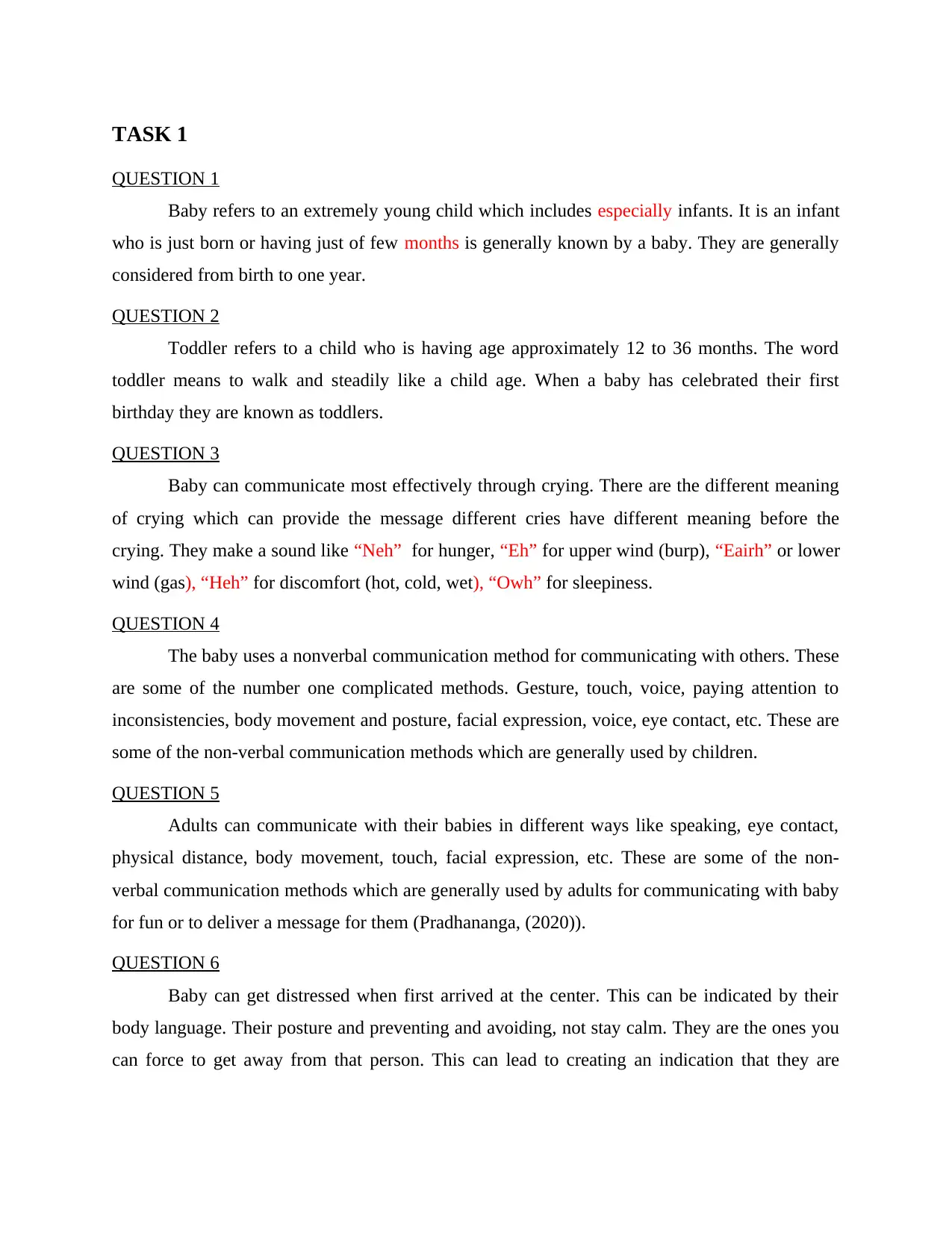
TASK 1
QUESTION 1
Baby refers to an extremely young child which includes especially infants. It is an infant
who is just born or having just of few months is generally known by a baby. They are generally
considered from birth to one year.
QUESTION 2
Toddler refers to a child who is having age approximately 12 to 36 months. The word
toddler means to walk and steadily like a child age. When a baby has celebrated their first
birthday they are known as toddlers.
QUESTION 3
Baby can communicate most effectively through crying. There are the different meaning
of crying which can provide the message different cries have different meaning before the
crying. They make a sound like “Neh” for hunger, “Eh” for upper wind (burp), “Eairh” or lower
wind (gas), “Heh” for discomfort (hot, cold, wet), “Owh” for sleepiness.
QUESTION 4
The baby uses a nonverbal communication method for communicating with others. These
are some of the number one complicated methods. Gesture, touch, voice, paying attention to
inconsistencies, body movement and posture, facial expression, voice, eye contact, etc. These are
some of the non-verbal communication methods which are generally used by children.
QUESTION 5
Adults can communicate with their babies in different ways like speaking, eye contact,
physical distance, body movement, touch, facial expression, etc. These are some of the non-
verbal communication methods which are generally used by adults for communicating with baby
for fun or to deliver a message for them (Pradhananga, (2020)).
QUESTION 6
Baby can get distressed when first arrived at the center. This can be indicated by their
body language. Their posture and preventing and avoiding, not stay calm. They are the ones you
can force to get away from that person. This can lead to creating an indication that they are
QUESTION 1
Baby refers to an extremely young child which includes especially infants. It is an infant
who is just born or having just of few months is generally known by a baby. They are generally
considered from birth to one year.
QUESTION 2
Toddler refers to a child who is having age approximately 12 to 36 months. The word
toddler means to walk and steadily like a child age. When a baby has celebrated their first
birthday they are known as toddlers.
QUESTION 3
Baby can communicate most effectively through crying. There are the different meaning
of crying which can provide the message different cries have different meaning before the
crying. They make a sound like “Neh” for hunger, “Eh” for upper wind (burp), “Eairh” or lower
wind (gas), “Heh” for discomfort (hot, cold, wet), “Owh” for sleepiness.
QUESTION 4
The baby uses a nonverbal communication method for communicating with others. These
are some of the number one complicated methods. Gesture, touch, voice, paying attention to
inconsistencies, body movement and posture, facial expression, voice, eye contact, etc. These are
some of the non-verbal communication methods which are generally used by children.
QUESTION 5
Adults can communicate with their babies in different ways like speaking, eye contact,
physical distance, body movement, touch, facial expression, etc. These are some of the non-
verbal communication methods which are generally used by adults for communicating with baby
for fun or to deliver a message for them (Pradhananga, (2020)).
QUESTION 6
Baby can get distressed when first arrived at the center. This can be indicated by their
body language. Their posture and preventing and avoiding, not stay calm. They are the ones you
can force to get away from that person. This can lead to creating an indication that they are
⊘ This is a preview!⊘
Do you want full access?
Subscribe today to unlock all pages.

Trusted by 1+ million students worldwide
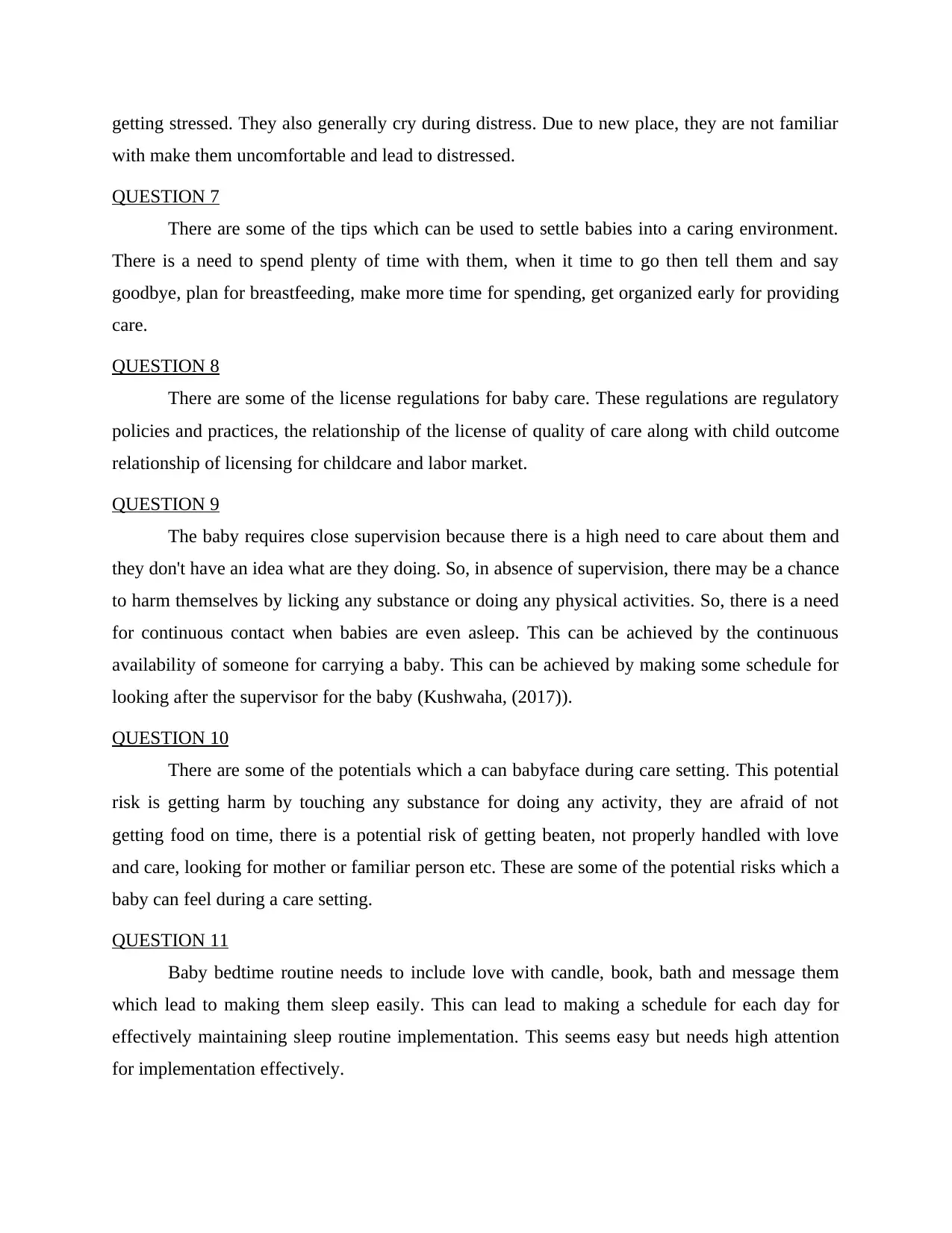
getting stressed. They also generally cry during distress. Due to new place, they are not familiar
with make them uncomfortable and lead to distressed.
QUESTION 7
There are some of the tips which can be used to settle babies into a caring environment.
There is a need to spend plenty of time with them, when it time to go then tell them and say
goodbye, plan for breastfeeding, make more time for spending, get organized early for providing
care.
QUESTION 8
There are some of the license regulations for baby care. These regulations are regulatory
policies and practices, the relationship of the license of quality of care along with child outcome
relationship of licensing for childcare and labor market.
QUESTION 9
The baby requires close supervision because there is a high need to care about them and
they don't have an idea what are they doing. So, in absence of supervision, there may be a chance
to harm themselves by licking any substance or doing any physical activities. So, there is a need
for continuous contact when babies are even asleep. This can be achieved by the continuous
availability of someone for carrying a baby. This can be achieved by making some schedule for
looking after the supervisor for the baby (Kushwaha, (2017)).
QUESTION 10
There are some of the potentials which a can babyface during care setting. This potential
risk is getting harm by touching any substance for doing any activity, they are afraid of not
getting food on time, there is a potential risk of getting beaten, not properly handled with love
and care, looking for mother or familiar person etc. These are some of the potential risks which a
baby can feel during a care setting.
QUESTION 11
Baby bedtime routine needs to include love with candle, book, bath and message them
which lead to making them sleep easily. This can lead to making a schedule for each day for
effectively maintaining sleep routine implementation. This seems easy but needs high attention
for implementation effectively.
with make them uncomfortable and lead to distressed.
QUESTION 7
There are some of the tips which can be used to settle babies into a caring environment.
There is a need to spend plenty of time with them, when it time to go then tell them and say
goodbye, plan for breastfeeding, make more time for spending, get organized early for providing
care.
QUESTION 8
There are some of the license regulations for baby care. These regulations are regulatory
policies and practices, the relationship of the license of quality of care along with child outcome
relationship of licensing for childcare and labor market.
QUESTION 9
The baby requires close supervision because there is a high need to care about them and
they don't have an idea what are they doing. So, in absence of supervision, there may be a chance
to harm themselves by licking any substance or doing any physical activities. So, there is a need
for continuous contact when babies are even asleep. This can be achieved by the continuous
availability of someone for carrying a baby. This can be achieved by making some schedule for
looking after the supervisor for the baby (Kushwaha, (2017)).
QUESTION 10
There are some of the potentials which a can babyface during care setting. This potential
risk is getting harm by touching any substance for doing any activity, they are afraid of not
getting food on time, there is a potential risk of getting beaten, not properly handled with love
and care, looking for mother or familiar person etc. These are some of the potential risks which a
baby can feel during a care setting.
QUESTION 11
Baby bedtime routine needs to include love with candle, book, bath and message them
which lead to making them sleep easily. This can lead to making a schedule for each day for
effectively maintaining sleep routine implementation. This seems easy but needs high attention
for implementation effectively.
Paraphrase This Document
Need a fresh take? Get an instant paraphrase of this document with our AI Paraphraser
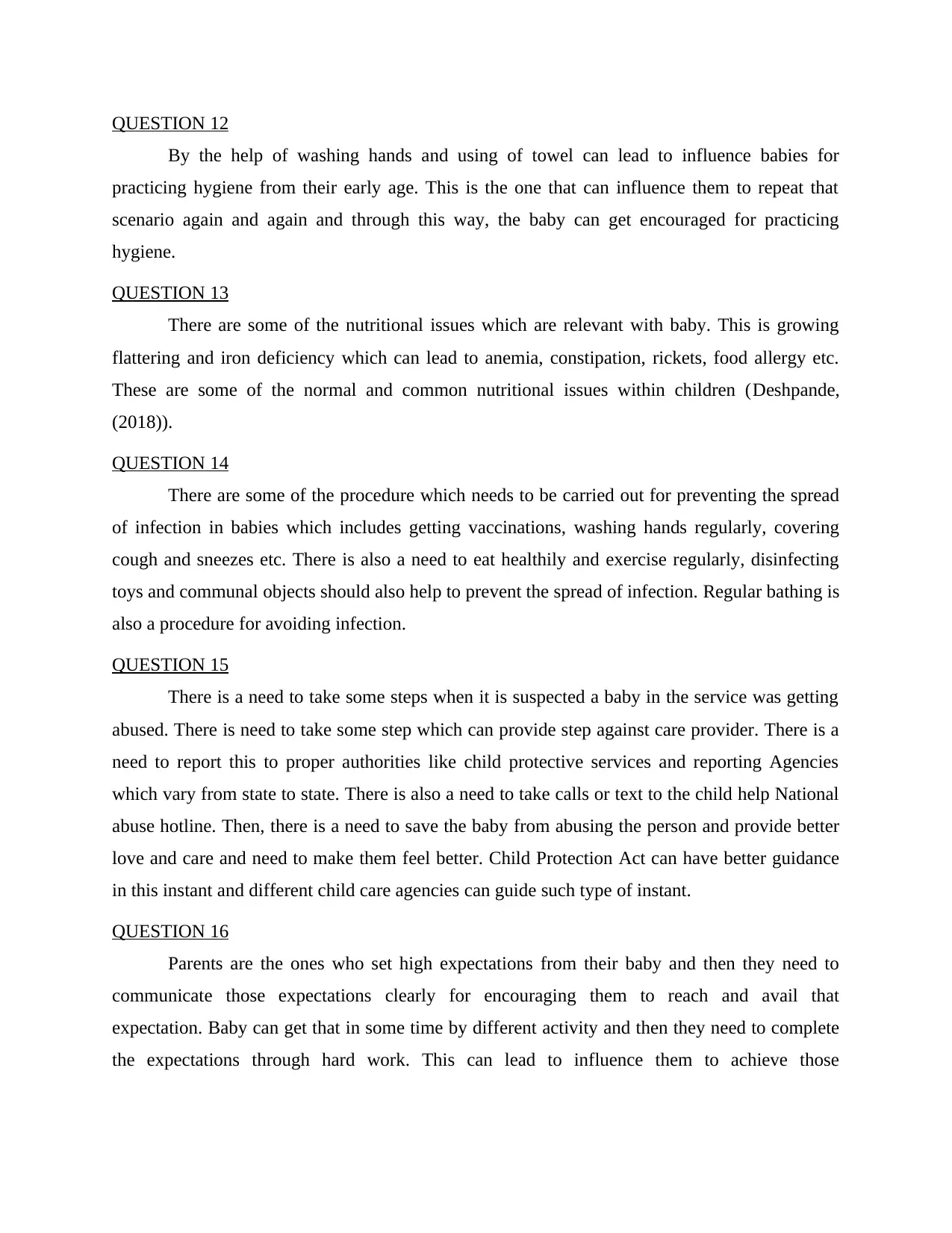
QUESTION 12
By the help of washing hands and using of towel can lead to influence babies for
practicing hygiene from their early age. This is the one that can influence them to repeat that
scenario again and again and through this way, the baby can get encouraged for practicing
hygiene.
QUESTION 13
There are some of the nutritional issues which are relevant with baby. This is growing
flattering and iron deficiency which can lead to anemia, constipation, rickets, food allergy etc.
These are some of the normal and common nutritional issues within children (Deshpande,
(2018)).
QUESTION 14
There are some of the procedure which needs to be carried out for preventing the spread
of infection in babies which includes getting vaccinations, washing hands regularly, covering
cough and sneezes etc. There is also a need to eat healthily and exercise regularly, disinfecting
toys and communal objects should also help to prevent the spread of infection. Regular bathing is
also a procedure for avoiding infection.
QUESTION 15
There is a need to take some steps when it is suspected a baby in the service was getting
abused. There is need to take some step which can provide step against care provider. There is a
need to report this to proper authorities like child protective services and reporting Agencies
which vary from state to state. There is also a need to take calls or text to the child help National
abuse hotline. Then, there is a need to save the baby from abusing the person and provide better
love and care and need to make them feel better. Child Protection Act can have better guidance
in this instant and different child care agencies can guide such type of instant.
QUESTION 16
Parents are the ones who set high expectations from their baby and then they need to
communicate those expectations clearly for encouraging them to reach and avail that
expectation. Baby can get that in some time by different activity and then they need to complete
the expectations through hard work. This can lead to influence them to achieve those
By the help of washing hands and using of towel can lead to influence babies for
practicing hygiene from their early age. This is the one that can influence them to repeat that
scenario again and again and through this way, the baby can get encouraged for practicing
hygiene.
QUESTION 13
There are some of the nutritional issues which are relevant with baby. This is growing
flattering and iron deficiency which can lead to anemia, constipation, rickets, food allergy etc.
These are some of the normal and common nutritional issues within children (Deshpande,
(2018)).
QUESTION 14
There are some of the procedure which needs to be carried out for preventing the spread
of infection in babies which includes getting vaccinations, washing hands regularly, covering
cough and sneezes etc. There is also a need to eat healthily and exercise regularly, disinfecting
toys and communal objects should also help to prevent the spread of infection. Regular bathing is
also a procedure for avoiding infection.
QUESTION 15
There is a need to take some steps when it is suspected a baby in the service was getting
abused. There is need to take some step which can provide step against care provider. There is a
need to report this to proper authorities like child protective services and reporting Agencies
which vary from state to state. There is also a need to take calls or text to the child help National
abuse hotline. Then, there is a need to save the baby from abusing the person and provide better
love and care and need to make them feel better. Child Protection Act can have better guidance
in this instant and different child care agencies can guide such type of instant.
QUESTION 16
Parents are the ones who set high expectations from their baby and then they need to
communicate those expectations clearly for encouraging them to reach and avail that
expectation. Baby can get that in some time by different activity and then they need to complete
the expectations through hard work. This can lead to influence them to achieve those
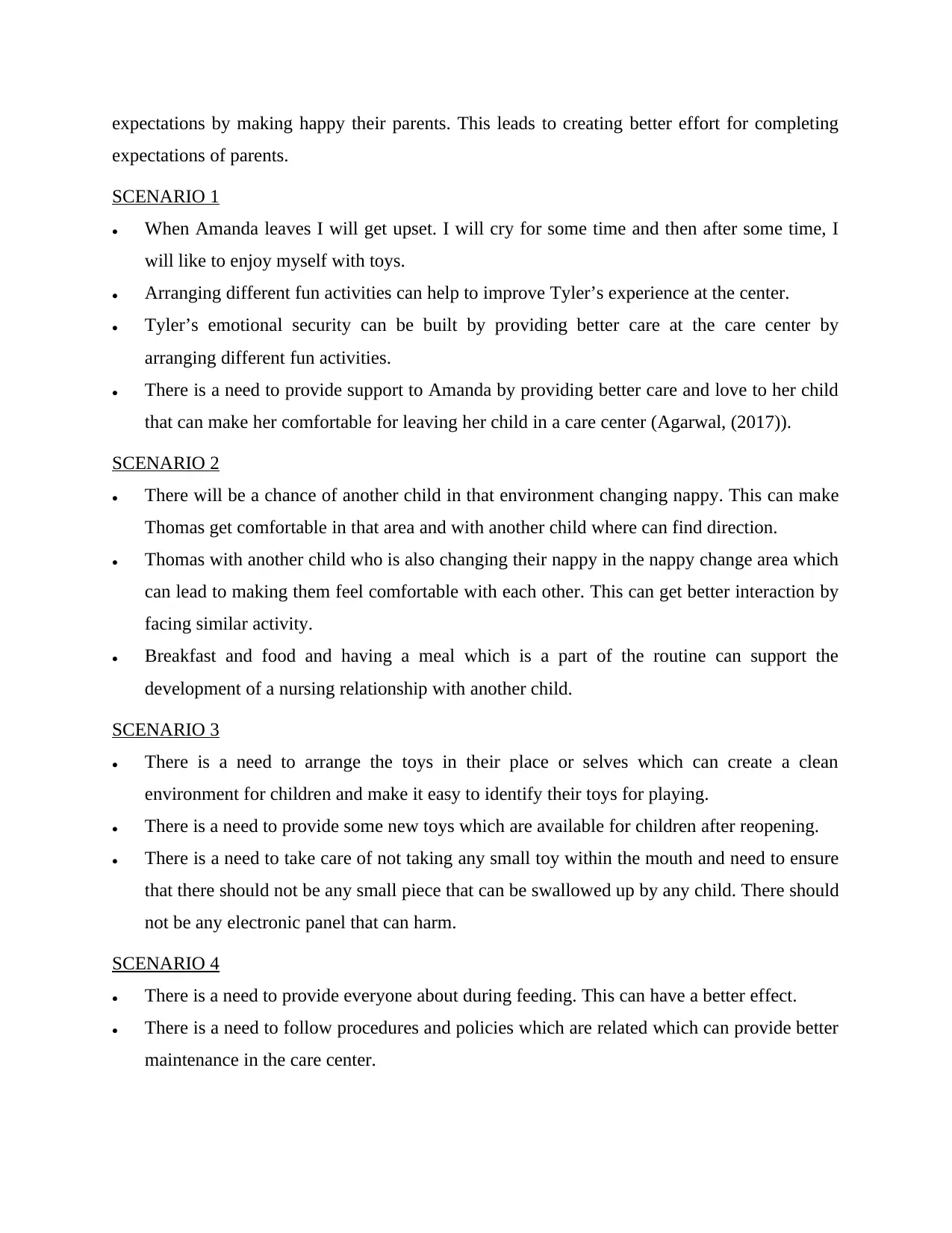
expectations by making happy their parents. This leads to creating better effort for completing
expectations of parents.
SCENARIO 1
When Amanda leaves I will get upset. I will cry for some time and then after some time, I
will like to enjoy myself with toys.
Arranging different fun activities can help to improve Tyler’s experience at the center.
Tyler’s emotional security can be built by providing better care at the care center by
arranging different fun activities.
There is a need to provide support to Amanda by providing better care and love to her child
that can make her comfortable for leaving her child in a care center (Agarwal, (2017)).
SCENARIO 2
There will be a chance of another child in that environment changing nappy. This can make
Thomas get comfortable in that area and with another child where can find direction.
Thomas with another child who is also changing their nappy in the nappy change area which
can lead to making them feel comfortable with each other. This can get better interaction by
facing similar activity.
Breakfast and food and having a meal which is a part of the routine can support the
development of a nursing relationship with another child.
SCENARIO 3
There is a need to arrange the toys in their place or selves which can create a clean
environment for children and make it easy to identify their toys for playing.
There is a need to provide some new toys which are available for children after reopening.
There is a need to take care of not taking any small toy within the mouth and need to ensure
that there should not be any small piece that can be swallowed up by any child. There should
not be any electronic panel that can harm.
SCENARIO 4
There is a need to provide everyone about during feeding. This can have a better effect.
There is a need to follow procedures and policies which are related which can provide better
maintenance in the care center.
expectations of parents.
SCENARIO 1
When Amanda leaves I will get upset. I will cry for some time and then after some time, I
will like to enjoy myself with toys.
Arranging different fun activities can help to improve Tyler’s experience at the center.
Tyler’s emotional security can be built by providing better care at the care center by
arranging different fun activities.
There is a need to provide support to Amanda by providing better care and love to her child
that can make her comfortable for leaving her child in a care center (Agarwal, (2017)).
SCENARIO 2
There will be a chance of another child in that environment changing nappy. This can make
Thomas get comfortable in that area and with another child where can find direction.
Thomas with another child who is also changing their nappy in the nappy change area which
can lead to making them feel comfortable with each other. This can get better interaction by
facing similar activity.
Breakfast and food and having a meal which is a part of the routine can support the
development of a nursing relationship with another child.
SCENARIO 3
There is a need to arrange the toys in their place or selves which can create a clean
environment for children and make it easy to identify their toys for playing.
There is a need to provide some new toys which are available for children after reopening.
There is a need to take care of not taking any small toy within the mouth and need to ensure
that there should not be any small piece that can be swallowed up by any child. There should
not be any electronic panel that can harm.
SCENARIO 4
There is a need to provide everyone about during feeding. This can have a better effect.
There is a need to follow procedures and policies which are related which can provide better
maintenance in the care center.
⊘ This is a preview!⊘
Do you want full access?
Subscribe today to unlock all pages.

Trusted by 1+ million students worldwide
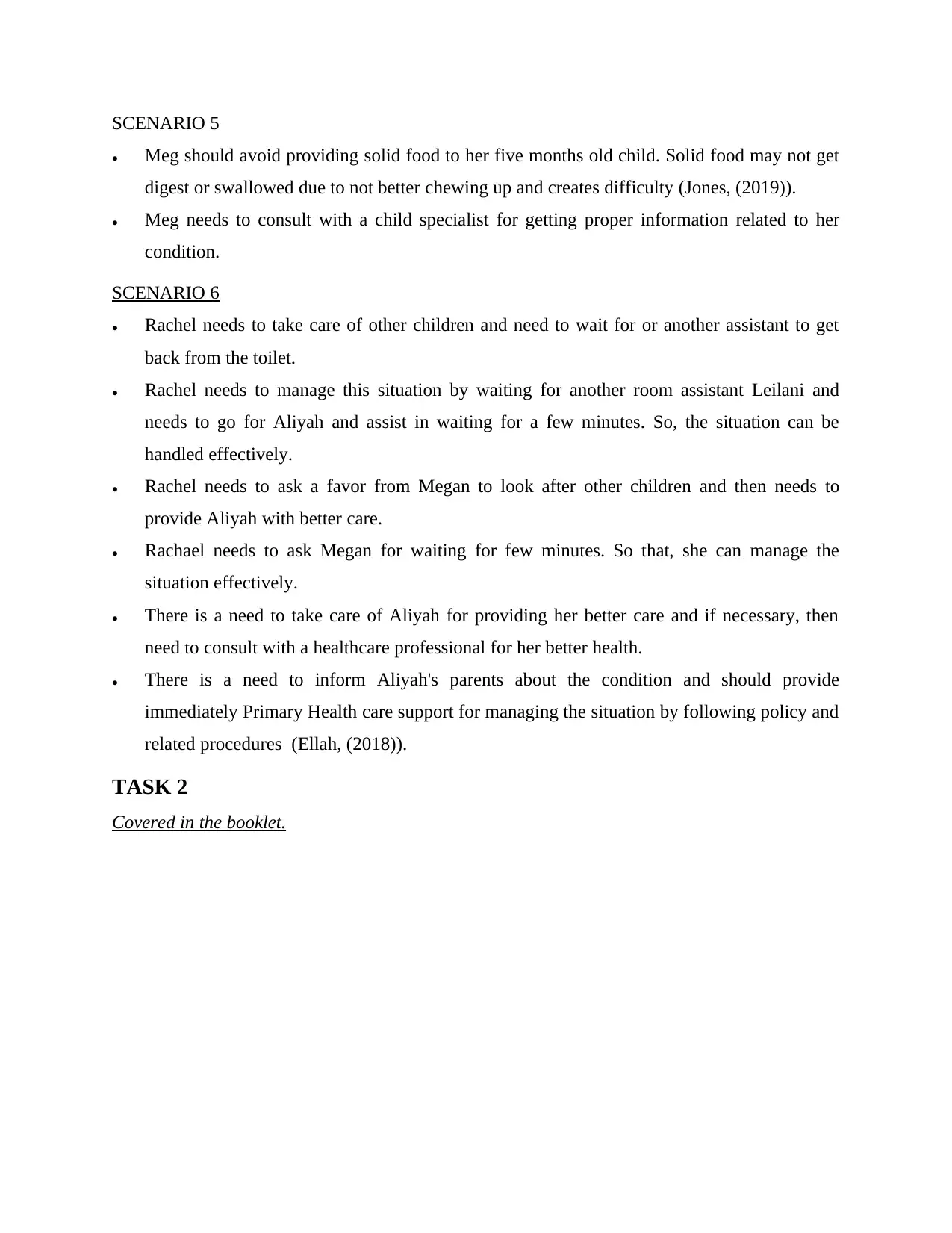
SCENARIO 5
Meg should avoid providing solid food to her five months old child. Solid food may not get
digest or swallowed due to not better chewing up and creates difficulty (Jones, (2019)).
Meg needs to consult with a child specialist for getting proper information related to her
condition.
SCENARIO 6
Rachel needs to take care of other children and need to wait for or another assistant to get
back from the toilet.
Rachel needs to manage this situation by waiting for another room assistant Leilani and
needs to go for Aliyah and assist in waiting for a few minutes. So, the situation can be
handled effectively.
Rachel needs to ask a favor from Megan to look after other children and then needs to
provide Aliyah with better care.
Rachael needs to ask Megan for waiting for few minutes. So that, she can manage the
situation effectively.
There is a need to take care of Aliyah for providing her better care and if necessary, then
need to consult with a healthcare professional for her better health.
There is a need to inform Aliyah's parents about the condition and should provide
immediately Primary Health care support for managing the situation by following policy and
related procedures (Ellah, (2018)).
TASK 2
Covered in the booklet.
Meg should avoid providing solid food to her five months old child. Solid food may not get
digest or swallowed due to not better chewing up and creates difficulty (Jones, (2019)).
Meg needs to consult with a child specialist for getting proper information related to her
condition.
SCENARIO 6
Rachel needs to take care of other children and need to wait for or another assistant to get
back from the toilet.
Rachel needs to manage this situation by waiting for another room assistant Leilani and
needs to go for Aliyah and assist in waiting for a few minutes. So, the situation can be
handled effectively.
Rachel needs to ask a favor from Megan to look after other children and then needs to
provide Aliyah with better care.
Rachael needs to ask Megan for waiting for few minutes. So that, she can manage the
situation effectively.
There is a need to take care of Aliyah for providing her better care and if necessary, then
need to consult with a healthcare professional for her better health.
There is a need to inform Aliyah's parents about the condition and should provide
immediately Primary Health care support for managing the situation by following policy and
related procedures (Ellah, (2018)).
TASK 2
Covered in the booklet.
Paraphrase This Document
Need a fresh take? Get an instant paraphrase of this document with our AI Paraphraser
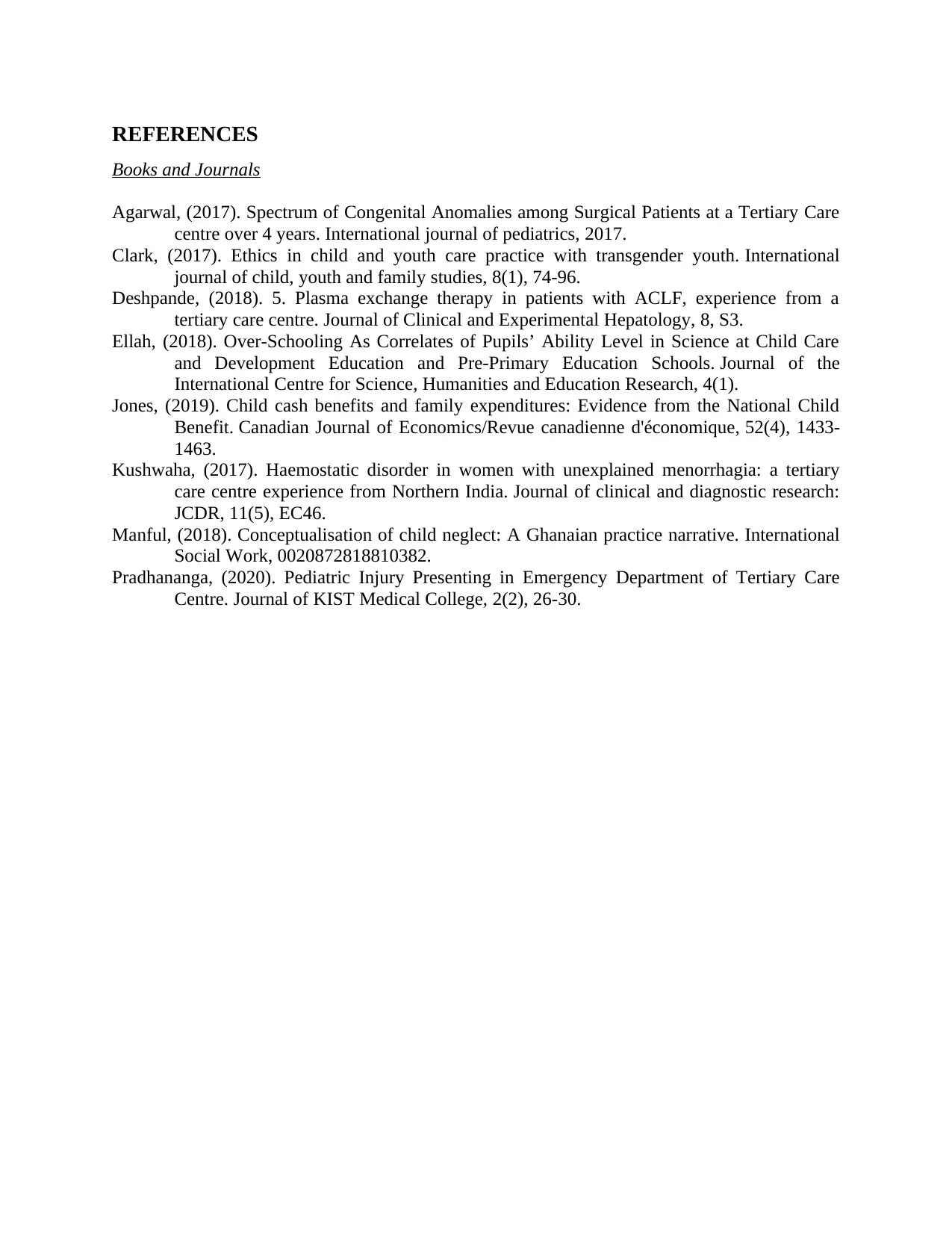
REFERENCES
Books and Journals
Agarwal, (2017). Spectrum of Congenital Anomalies among Surgical Patients at a Tertiary Care
centre over 4 years. International journal of pediatrics, 2017.
Clark, (2017). Ethics in child and youth care practice with transgender youth. International
journal of child, youth and family studies, 8(1), 74-96.
Deshpande, (2018). 5. Plasma exchange therapy in patients with ACLF, experience from a
tertiary care centre. Journal of Clinical and Experimental Hepatology, 8, S3.
Ellah, (2018). Over-Schooling As Correlates of Pupils’ Ability Level in Science at Child Care
and Development Education and Pre-Primary Education Schools. Journal of the
International Centre for Science, Humanities and Education Research, 4(1).
Jones, (2019). Child cash benefits and family expenditures: Evidence from the National Child
Benefit. Canadian Journal of Economics/Revue canadienne d'économique, 52(4), 1433-
1463.
Kushwaha, (2017). Haemostatic disorder in women with unexplained menorrhagia: a tertiary
care centre experience from Northern India. Journal of clinical and diagnostic research:
JCDR, 11(5), EC46.
Manful, (2018). Conceptualisation of child neglect: A Ghanaian practice narrative. International
Social Work, 0020872818810382.
Pradhananga, (2020). Pediatric Injury Presenting in Emergency Department of Tertiary Care
Centre. Journal of KIST Medical College, 2(2), 26-30.
Books and Journals
Agarwal, (2017). Spectrum of Congenital Anomalies among Surgical Patients at a Tertiary Care
centre over 4 years. International journal of pediatrics, 2017.
Clark, (2017). Ethics in child and youth care practice with transgender youth. International
journal of child, youth and family studies, 8(1), 74-96.
Deshpande, (2018). 5. Plasma exchange therapy in patients with ACLF, experience from a
tertiary care centre. Journal of Clinical and Experimental Hepatology, 8, S3.
Ellah, (2018). Over-Schooling As Correlates of Pupils’ Ability Level in Science at Child Care
and Development Education and Pre-Primary Education Schools. Journal of the
International Centre for Science, Humanities and Education Research, 4(1).
Jones, (2019). Child cash benefits and family expenditures: Evidence from the National Child
Benefit. Canadian Journal of Economics/Revue canadienne d'économique, 52(4), 1433-
1463.
Kushwaha, (2017). Haemostatic disorder in women with unexplained menorrhagia: a tertiary
care centre experience from Northern India. Journal of clinical and diagnostic research:
JCDR, 11(5), EC46.
Manful, (2018). Conceptualisation of child neglect: A Ghanaian practice narrative. International
Social Work, 0020872818810382.
Pradhananga, (2020). Pediatric Injury Presenting in Emergency Department of Tertiary Care
Centre. Journal of KIST Medical College, 2(2), 26-30.
1 out of 8
Related Documents
Your All-in-One AI-Powered Toolkit for Academic Success.
+13062052269
info@desklib.com
Available 24*7 on WhatsApp / Email
![[object Object]](/_next/static/media/star-bottom.7253800d.svg)
Unlock your academic potential
Copyright © 2020–2025 A2Z Services. All Rights Reserved. Developed and managed by ZUCOL.



